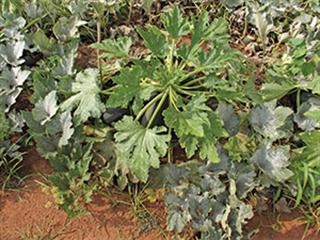
Butternuts, marrows, cucumbers and melons are more likely to be resistant. But for other cucurbits, as the season progresses beyond mid-summer, the likelihood of powdery mildew will increase. As this disease does not require free water on the leaves in order to develop, dry areas are not spared. The name says it all. The disease starts off as white, powdery spots that eventually cover the leaf. This disrupts leaf function, so that the yield and the flesh quality is reduced. Melons lose their sweetness and flavour, for example.
Many different species of fungi in the order Erysiphales cause powdery mildew. Each fungus has a rapid life cycle and adapts to counter resistant genes. Melons commonly have built-in resistance to three strains of mildew. Not all might be needed, however, as only a single strain of the disease might be predominant in a particular area.
A rapid life cycle also means that the fungus can develop resistance to fungicides.
Prophylactic
Resistance build-up is much slower in the case of fungicides with a prophylactic action, such as the diathiocarbimates. These products cover the leaf surface and prevent spores from developing. The only problem is that while it’s easy to spray the upper surface of the leaves, it is very difficult to wet the undersides. An alternative is to use bicarbonate of soda at 500g/100l of water with a wetting agent. All surfaces must be wetted thoroughly, so that they are shiny after spraying. A disadvantage of this treatment is that the solution washes off easily.
This leaves us with systemic products, which may be fully systemic or trans-laminar, where the product is able to move into the leaf from one wetted surface. It cannot move from this surface to other parts of the plant, however. Although systemic or translaminar treatments are a useful option, powdery mildew is able to build up resistance fairly rapidly to them.
At first, results are usually excellent – and herein lies the problem! Farmers tend to stick with the product until it is no longer effective, rendering it useless in that particular area. The only solution is to alternate the product with another suitable product in order to delay resistance build-up as long as possible.
The key word here is ‘suitable’. Some different chemicals may have similarities in mode of action so that resistance to one makes the entire group ineffective. It’s crucial, therefore, not to pick any alternative product at random. Discuss your control programme with a well-informed crop chemical salesperson, or contact the head office of the applicable chemical company. Bear in mind that it’s in their interests to see that resistance build-up is delayed with their product/s. For this reason, they may even recommend that you alternate treatment with an opposition product.
The dangers of spraying incorrectly
Equally important to choosing the right systemic product is getting the application right. By not spraying according to the instructions on the label, you might end up applying a weaker dose. Fungi with some tolerance to the product will survive and reproduce, passing their genes on to subsequent generations. This hastens the onset of resistance to the chemical.
A common problem is poor calibration.
Many farmers don’t know how to calibrate properly, or if they do, don’t check up on the spray operator to ensure that he is driving in the correct gear and/or using the correct pressure. All the initial calibration is thus rendered null and void. My first job was working for a large company that understood this well. All staff were directed to check the calibration before each operation and again during the spraying operation.
Contact Bill Kerr at [email protected]. Please state ‘Vegetable production’ in the subject line of your email.













